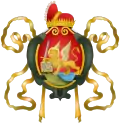History of Istria
Istria (Croatian and Slovene: Istra, Latin: Histria) is the largest peninsula in the Adriatic Sea. The peninsula is located at the head of the Adriatic between the Gulf of Trieste and the Bay of Kvarner. It is shared by three countries: Croatia, Slovenia, and Italy.
Prehistory
The first known appearance of human life in Istria dates to Lower Paleolithic, as evidenced by artifacts found in Šandalja Cave near Pula, dated to 800,000 BC.[1]
Since 11th century BC, Istria was inhabited by the Histri, a prehistoric Illyrian tribe after whom Istria was named.[1][2] Their arrival marks the beginning of the Iron Age in Istria.[1] Another Illyrian tribe that inhabited the area were the Liburnians. The westernmost extents of their land, Liburnia, covered the area east of the Raša River.[2]
Roman and Byzantine periods
.jpg.webp)
After a series of conflicts, the Romans conquered the Histri and took power of the Istria peninsula in 178 and 177 BC.[4] Romans established the port of Pietas Iulia (modern Pula)[5] and gradually converting the inland areas into latifundia, large estates worked by colonists and locals. Although pockets of Illyrian resistance remained in the hilly interior, they succumbed in time to the Romans’ combination of military and economic superiority. Although Pula is Istria's only settlement to preserve significant evidence of the Romans (principally its Forum and Amphitheater), most of Istria's major settlements were established in this period. Under Emperor Augustus, Istria was incorporated as a discrete region within the Roman province of Italia, making it an integral part of the Empire, which remained until the fall of the Western Roman Empire in 476.[6]
Christianity appeared in Istria in late 3rd century AD, and the first churches were built in the 4th century.[7] The period between 2nd and 5th century AD saw the incursions of Germanic tribes, a sustained influx of refugees from Pannonia and other provinces, political instability amid infighting for the Roman throne, and decline of the economy.[5][7]
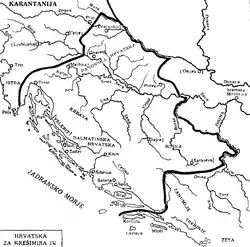
Following the fall of the Western Roman Empire, the region was conquered by the Ostrogoths in 489 AD.[7] In 538/539, it was incorporated into the Byzantine Empire[6][7] – which had endured as part of the Exarchate of Ravenna – and annexed to the Lombard Kingdom in 599. In the Avarian-Slavic invasions and inhabitation of the Slavs, in the beginning of 7th century, the inland towns were destroyed and abandoned, while the coastal area resisted these attacks. This period was highly contentious, because the attacks by the Lombards from the West, Slovene tribes from the north, and Croat tribes from the east and south resulted in a state of near constant conflict.
Frankish and Venetian rule
Istria was annexed to the Frankish kingdom by Pepin of Italy in 788.[8] The seeds of Istria's dissolution were sown under increasingly weak Frankish rule, which enabled most settlements to achieve de facto autonomy.
In the 10th and 11th centuries, Istria was ruled by the German feudal families. Since mid-11th century, Istria was a separate markgraviate,[9] given in hereditary feud to various families of noblemen by German emperors, the dukes of Carinthia, Merano and Bavaria.[10] The German emperor Henry IV nominally assigned the remaining march to the Patriarchate of Aquileia. According to Constantine Porphyrogennetos, eastern parts of Istria north of Raša River at that time belonged to Croatian Kingdom.[9][11]
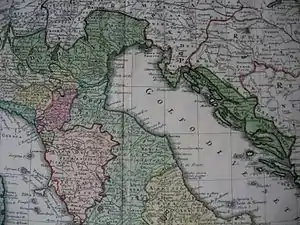
In 1145, the cities of Pula, Koper and Izola rose against the Republic of Venice but were defeated, and were since further controlled by Venice.[10] During the 13th century, the Patriarchate's rule weakened and the towns kept surrendering to Venice – Poreč in 1267, Umag in 1269, Novigrad in 1270, Sveti Lovreč in 1271, Motovun in 1278, Kopar in 1279, and Piran and Rovinj in 1283.[10] Venice gradually dominated the whole coastal area of western Istria and the area to Plomin on the eastern part of the peninsula.[10] The wealthier coastal towns cultivated increasingly strong economic relationships with Venice and by 1348 were eventually incorporated into its territory, while their inland counterparts fell under the sway of the weaker Patriarchate of Aquileia, which became part of the Habsburg Empire in 1374.
Habsburg rule
The inner Istrian part around the town of Pazin (German: Mitterburg), named Pazin County (Croatian: Pazinska knežija or Pazinska grofovija), with its stronghold Pazin Castle, was held for centuries by the members of the House of Habsburg and was part of the Habsburg Empire (Holy Roman Empire). The Venetian part of the peninsula passed to it in 1797 with the Treaty of Campo Formio.
Napoleonic rule
Following the fall of the Venetian Republic (1797), Istria was occupied by Napoleon; however, he gave Venice and the Venetian part of Istria and Dalmatia to Austria, in exchange for the Netherlands and Lombardia.
In 1805, Napoleon re-occupied the former Venetian Istria. The Holy Roman Empire ended with the period of Napoleonic rule from 1805 to 1813, when Istria became part of the Italian Kingdom and, from 1809, of the Illyrian provinces of the Napoleonic Empire. For the first time, inner and eastern parts of Istria became a part of Croatia, as a part of Civil Croatia, established by Napoleon.
Austrian rule
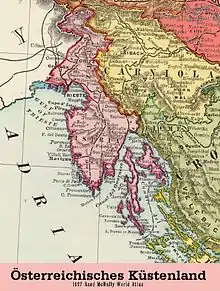
After this short period, the newly established Austrian Empire ruled entire Istrian territory from 1814 until 1918. Istria became the part of the Empire as a separate territorial unit, with Trieste as its capital. Pazin became its capital in 1825. In 1866 Pula became the capital port of the Austrian Empire Navy.
The introduction of limited democracy in 1861, by means of a regional parliament (Diet of Istria) that convened at Parezzo (Poreč), only served to its purpose to the Austrians in defusing Italian calls for the region's union with the newly established Kingdom of Italy, as suffrage was limited to property owners, who were primarily Italian. The first parliament consisted of 28 Italians, but only one Croat and one Slovene.
In the second half of the 19th century, there was a fight for the national and political rights of the Croatian and Slovenian population in relation to the Italian population, strongly influenced by the Croatian national revival. Bishop Juraj Dobrila was the leader of the battle for Croatian rights in Istria. His concept was the activation of the people in the field of the national self-defence, the preservation of tradition, the improvement of economic and political situation, the acceptance of new civilization and cultural achievements, and finding the way to take the people out of misery. In one of his first demands to the Istrian Parliament in Poreč, he asked that the Croatian should become the official language, along with Italian.
With the First World War, national fights were interrupted. Italian interest in the eastern part of the Adriatic coast became very obvious. A secret agreement was made in London in April 1915, according to which Italy was promised South Tyrol, a part of Dalmatia and Istria with Trieste and Gorizia.
Italy
Part of a series on the |
|---|
| History of Italy |
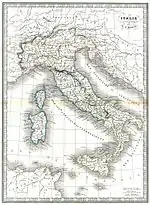 |
|
|
At the end of the First World War, Austria-Hungary was defeated in the battle of Vittorio Veneto and asked for an armistice, signed in Padova, on 3 November 1918. Istria was consequently occupied by the Italian Royal Army, under the terms of the armistice. At the peace conference in Paris, Italy was between the winning powers, and obtained the suzerainty over Istria, according to the terms of London Treaty.
After the advent of Fascism in 1922, the portions of the Istrian population that were Croatian and Slovene were exposed to a policy of forced Italianization and cultural suppression. During the period between the two world wars, Italians eradicated Croatian and Slovenian public and national life. They abolished all Croatian schools, cultural institutions and associations, and Croatian names were Italianized. Croatians lost their right to education and religious practice in their maternal languages. The population emigrated to the Kingdom of Yugoslavia on a large scale. The organization TIGR, regarded as the first armed antifascist resistance group in Europe, was founded in 1927 and soon penetrated into Slovene and Croatian-speaking parts of Istria.
After the capitulation of Italy in the Second World War, The Yugoslav Partisans officially occupied the region, expelled the fascist authorities, and established the rule of the National Liberation Movement in Croatia which sought to incorporate Istra into the Croatian state. However, the Yugoslav executive was forced split Istria into two Zones: the Anglo-American-occupied Zone A and the Yugoslav-administrated Zone B. These zones would eventually be abolished by the Paris Peace Treaties of 1947. The capitulation of Italy, and the ensuing struggle over Istria, caused acts of massacres such as the Foibe massacres which were often partly or wholly committed by the local non-Italian population, due to the previous regime's oppression of non-Italians like such as forced Italianization which was the leading cause of resentment. This lingered and triggered the Istrian-Dalmatian exodus which significantly reduced the Italian population in Istria, particularly in urban areas.[12][13]
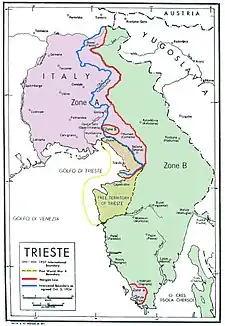
Period of Yugoslavia
According to the Paris Peace Treaty of 1947, the territory between Novigrad and Trieste became the independent Free Territory of Trieste, while other parts were incorporated into Yugoslavia. The Free Territory of Trieste was also divided in two zones – Zone A (area around Trieste) and Zone B (the rest). Zone A was again under the Anglo-American administration, while Zone B was under the Yugoslav military administration, from which area most of the Italian population fled. After the dissolution of the Free Territory of Trieste in 1954, by London agreement, Italy was assigned Zone A, the region up to the present-day Slovenian/Italian border, while the remaining territory was incorporated into Yugoslavia as a part of its People's Republic of Croatia and the People's Republic of Slovenia. For the first time, the entire western coast of Istria became part of Croatia. The final border between the two states was defined in the agreement in the Italian town of Osimo (Treaty of Osimo) on 10 November 1975.
In independent Croatia
Following the break-up of Yugoslavia in 1991, and international recognition of independent states of Croatia and Slovenia, the division of Istria between Croatia and Slovenia runs on the former republic borders. In December 1992, Istria became one of the twenty counties in the Republic of Croatia.[14][15] The Gulf of Piran area is the subject of an ongoing border dispute between Croatia and Slovenia.[16]
See also
Part of a series on the |
|---|
| History of Croatia |
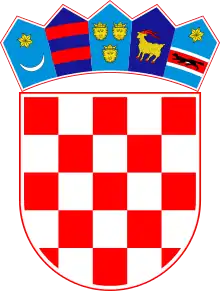 |
| Timeline |
|
|
References
- Istrapedia I, Prapovijest.
- Istra-Istria.hr, THE HISTRI AND THE LIBURNI.
- Džin 2009, p. 7.
- Istrapedia I, Histri u kasno željezno doba.
- Istrapedia I, Kraj Rimske Republike i početak Carstva.
- Istra-Istria.hr, ROMAN PERIOD.
- Istrapedia I, Kasno rimsko doba.
- Istrapedia I, Rani srednji vijek.
- Istrapedia I, Razvijeni srednji vijek.
- Istra-Istria.hr, VARIOUS RULERS.
- Istra-Istria.hr, FRANK RULE.
- Stallaerts, Rober (22 December 2009). Historical Dictionary of Croatia (3rd ed.). The Scarecrow Press. p. 175. ISBN 9780810873636. Retrieved 2018-10-10.
- Istrapedia II, Poraće (1945–54).
- Istra-Istria.hr, THE REPUBLIC OF CROATIA.
- Istrapedia II, Devedesete.
- "Slovenia-Croatia border dispute underlines fragility of EU's Balkan project". Irish Times. 4 January 2018. Retrieved 2018-12-20.
Bibliography
- "Povijest (Povijest Istre od prapovijesti do 1918. g.)". Istrapedia (in Croatian). Retrieved 2015-12-10.
- "Povijest (Povijest Istre od 1918.- 2000. g.)". Istrapedia (in Croatian). Retrieved 2015-12-10.
- "Historic overview-more details". Istra-Istria.hr. Istria County. Retrieved 2018-12-19.
- Džin, Kristina (2009). Žužić, Mirko (ed.). Arena Pula. Zagreb: Viza MG d.o.o. ISBN 978-953-7422-15-8.
External links
 Media related to History of Istria at Wikimedia Commons
Media related to History of Istria at Wikimedia Commons

